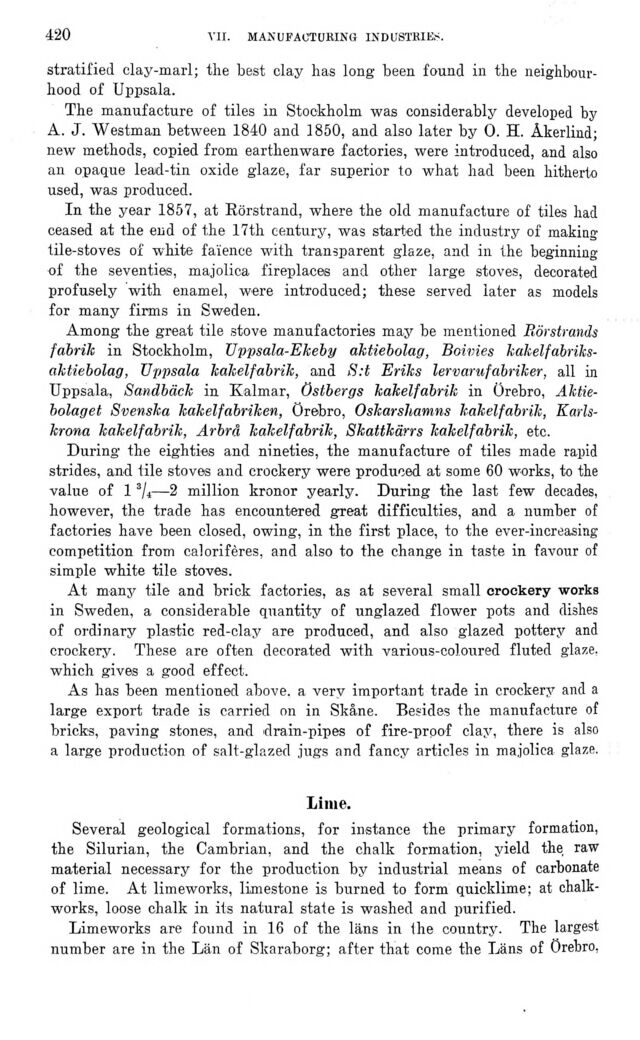
Full resolution (JPEG) - On this page / på denna sida - VII. Manufacturing Industries. Introd. by [G. Sundbärg] K. Åmark - 8. Manufactures of Stone, Clay, Coal, Charcoal, and Peat - Tile Stoves and Crockery. By H. Almström - Lime. By Alf. Larson

<< prev. page << föreg. sida << >> nästa sida >> next page >>
Below is the raw OCR text
from the above scanned image.
Do you see an error? Proofread the page now!
Här nedan syns maskintolkade texten från faksimilbilden ovan.
Ser du något fel? Korrekturläs sidan nu!
This page has never been proofread. / Denna sida har aldrig korrekturlästs.
420
vii. manufacturing industries.
stratified clay-marl; the best clay has long been found in the
neighbourhood of Uppsala.
The manufacture of tiles in Stockholm was considerably developed by
A. J. Westman between 1840 and 1850, and also later by O. H. Åkerlind;
new methods, copied from earthenware factories, were introduced, and also
an opaque leacl-tin oxide glaze, far superior to what had been hitherto
used, was produced.
In the year 1857, at Rörstrand, where the old manufacture of tiles had
ceased at the end of the 17th century, was started the industry of making
tile-stoves of white faience with transparent glaze, and in the beginning
of the seventies, majolica fireplaces and other large stoves, decorated
profusely with enamel, were introduced; these served later as models
for many firms in Sweden.
Among the great tile ,stove manufactories may be mentioned Rörstrands
fabrik in Stockholm, TJppsala-Ekeby aktiebolag, Boivies
kakelfabriks-aktiebolag, Uppsala kakelfabrik, and S:l Eriks lervarufabriker, all in
Uppsala, Sandbäck in Kalmar, Östbergs kakelfabrik in Örebro,
Aktiebolaget Svenska kakelfabriken, Örebro, Oskarshamns kakelfabrik,
Karlskrona kakelfabrik, Arbrå kakelfabrik, Skattkärrs kakelfabrik, etc.
During the eighties and nineties, the manufacture of tiles made rapid
strides, and tile stoves and crockery were produced at some 60 works, to the
value of 1 sli—2 million kronor yearly. During the last few decades,
however, the trade has encountered great difficulties, and a number of
factories have been closed, owing, in the first place, to the ever-increasing
competition from calorifères, and also to the change in taste in favour of
simple white tile stoves.
At many tile and brick factories, as at several small crockery works
in Sweden, a considerable quantity of unglazed flower pots and dishes
of ordinary plastic red-clay are produced, and also glazed pottery and
crockery. These are often decorated with various-coloured fluted glaze,
which gives a good effect.
As has been mentioned above, a verv important trade in crockery and a
large export trade is carried on in Skåne. Besides the manufacture of
bricks, paving stones, and drain-pipes of fire-proof clay, there is also
a large production of salt-glazed jugs and fancy articles in majolica glaze.
Lime.
Several geological formations, for instance the primary formation,
the Silurian, the Cambrian, and the chalk formation, yield the raw
material necessary for the production by industrial means of carbonate
of lime. At limeworks, limestone is burned to form quicklime; at
chalk-works, loose chalk in its natural state is washed and purified.
Limeworks are found in 16 of the läns in the country. The largest
number are in the Län of Skaraborg; after that come the Läns of Örebro,
<< prev. page << föreg. sida << >> nästa sida >> next page >>